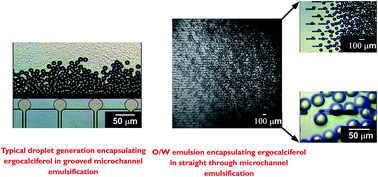Formulation characteristics of triacylglycerol oil-in-water emulsions loaded with ergocalciferol using microchannel emulsification
Abstract
Ergocalciferol is one important form of vitamin D that is needed for proper functioning of the human metabolic system. The study formulates monodisperse food grade ergocalciferol loaded oil-in-water (O/W) emulsions by microchannel emulsification (MCE). The primary characterization was performed with grooved MCE, while the storage stability and encapsulating efficiency (EE) were investigated with straight-through MCE. The grooved microchannel (MC) array plate has 5 × 18 μm MCs, while the asymmetric straight-through MC array plate consists of numerous 10 × 80 μm microslots each connected to a 10 μm diameter circular MC. Ergocalciferol at a concentration of 0.2–1.0% (w/w) was added to various oils and served as the dispersed phase, while the continuous phase constituted either of 1% (w/w) Tween 20, decaglycerol monolaurate (Sunsoft A-12) or β-lactoglobulin. The primary characterization indicated successful emulsification in the presence of 1% (w/w) Tween 20 or Sunsoft A-12. The average droplet diameter increased slowly with the increasing concentration of ergocalciferol and ranged from 28.3 to 30.0 μm with a coefficient of variation below 6.0%. Straight-through MCE was conducted with 0.5% (w/w) ergocalciferol in soybean oil together with 1% (w/w) Tween 20 in Milli-Q water as the optimum dispersed and continuous phases. Monodisperse O/W emulsions with a Sauter mean diameter (d3,2) of 34 μm with a relative span factor of less than 0.2 were successfully obtained from straight-through MCE. The resultant oil droplets were physically stable for 15 days (d) at 4 °C without any significant increase in d3,2. The monodisperse O/W emulsions exhibited an ergocalciferol EE of more than 75% during the storage period.


 Please wait while we load your content...
Please wait while we load your content...